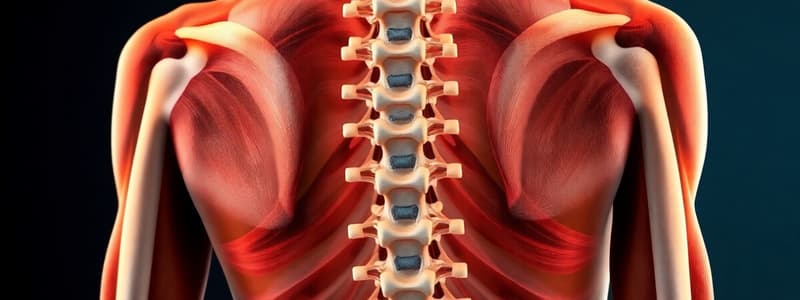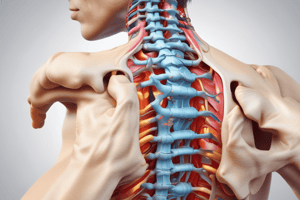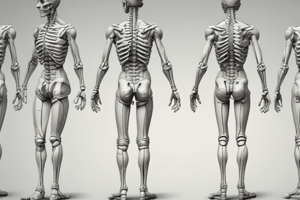Podcast
Questions and Answers
What is the primary objective of conservative treatment for scoliosis?
What is the primary objective of conservative treatment for scoliosis?
- To stop curve progression at puberty or reduce it (correct)
- To enhance muscular strength in the spine
- To guarantee complete spinal correction
- To eliminate all pain syndromes immediately
Which therapeutic approach includes auto-correction in three dimensions as a defining characteristic?
Which therapeutic approach includes auto-correction in three dimensions as a defining characteristic?
- Bracing
- Traditional physiotherapy
- Physiotherapeutic Scoliosis Specific Exercises (PSSE) (correct)
- Spinal Fusion
What is the most common type of surgery performed for severe scoliosis?
What is the most common type of surgery performed for severe scoliosis?
- Vertebroplasty
- Laminectomy
- Kyphoplasty
- Spinal fusion (correct)
Which option is NOT listed as an objective of conservative treatment for scoliosis?
Which option is NOT listed as an objective of conservative treatment for scoliosis?
What is the purpose of the Boston brace in scoliosis management?
What is the purpose of the Boston brace in scoliosis management?
What characterizes the tonic muscle system in terms of function?
What characterizes the tonic muscle system in terms of function?
Which muscle is considered phasic and prone to weakness in the upper quarter?
Which muscle is considered phasic and prone to weakness in the upper quarter?
Which of the following best defines muscle imbalance?
Which of the following best defines muscle imbalance?
Which of the following muscles is part of the tonic system in the lower quarter?
Which of the following muscles is part of the tonic system in the lower quarter?
What is upper crossed syndrome primarily characterized by?
What is upper crossed syndrome primarily characterized by?
Which muscles are primarily responsible for tightness in the upper quarter tonic system?
Which muscles are primarily responsible for tightness in the upper quarter tonic system?
Which of the following muscles would likely experience weakness in an individual with lower crossed syndrome?
Which of the following muscles would likely experience weakness in an individual with lower crossed syndrome?
Which of the following statements is false regarding the classification of muscles prone to tightness or weakness?
Which of the following statements is false regarding the classification of muscles prone to tightness or weakness?
What defines scoliosis in terms of its anatomical features?
What defines scoliosis in terms of its anatomical features?
Which type of scoliosis is reversible and can be adjusted with physical positioning?
Which type of scoliosis is reversible and can be adjusted with physical positioning?
What percentage of scoliosis cases are classified as idiopathic?
What percentage of scoliosis cases are classified as idiopathic?
What effect does advanced structural scoliosis have on rib expansion?
What effect does advanced structural scoliosis have on rib expansion?
In the context of scoliosis, what does the rotation of vertebral bodies indicate?
In the context of scoliosis, what does the rotation of vertebral bodies indicate?
What is the consequence of muscle imbalance in Upper Crossed Syndrome?
What is the consequence of muscle imbalance in Upper Crossed Syndrome?
What common condition can lead to non-structural scoliosis?
What common condition can lead to non-structural scoliosis?
Which of the following is not a postural change associated with Lower Crossed Syndrome?
Which of the following is not a postural change associated with Lower Crossed Syndrome?
Which muscles are tight in someone with Upper Crossed Syndrome?
Which muscles are tight in someone with Upper Crossed Syndrome?
Which of the following statements about the age onset of scoliosis is accurate?
Which of the following statements about the age onset of scoliosis is accurate?
Which of the following best describes a structural curve in scoliosis?
Which of the following best describes a structural curve in scoliosis?
What joint primarily experiences dysfunction due to Lower Crossed Syndrome?
What joint primarily experiences dysfunction due to Lower Crossed Syndrome?
What is the significance of a Cobb angle of 10° or higher?
What is the significance of a Cobb angle of 10° or higher?
What is a common symptom of both Upper Crossed Syndrome and Lower Crossed Syndrome?
What is a common symptom of both Upper Crossed Syndrome and Lower Crossed Syndrome?
Which of the following symptoms may indicate a worsening scoliosis curve?
Which of the following symptoms may indicate a worsening scoliosis curve?
What factor is NOT relevant in predicting the risk of scoliosis curve progression?
What factor is NOT relevant in predicting the risk of scoliosis curve progression?
Which pattern of tightness is indicative of Lower Crossed Syndrome?
Which pattern of tightness is indicative of Lower Crossed Syndrome?
Which type of scoliosis curve is generally more prone to worsening?
Which type of scoliosis curve is generally more prone to worsening?
Which of these conditions is most likely caused by Upper Crossed Syndrome?
Which of these conditions is most likely caused by Upper Crossed Syndrome?
What indicates a normal position of the vertebrae using the pedicle method?
What indicates a normal position of the vertebrae using the pedicle method?
Weakness of which muscle is most likely to result in overactivity of the hamstrings in Lower Crossed Syndrome?
Weakness of which muscle is most likely to result in overactivity of the hamstrings in Lower Crossed Syndrome?
What is the relationship between maturity and the risk of curve progression in scoliosis?
What is the relationship between maturity and the risk of curve progression in scoliosis?
Which sign is NOT commonly associated with scoliosis?
Which sign is NOT commonly associated with scoliosis?
Which treatment option is typically suggested for a Cobb angle between 25° and 45°?
Which treatment option is typically suggested for a Cobb angle between 25° and 45°?
Flashcards
Boston Brace
Boston Brace
A brace worn to stop the progression of scoliosis in children during puberty.
Physiotherapeutic Scoliosis Specific Exercises (PSSE)
Physiotherapeutic Scoliosis Specific Exercises (PSSE)
A series of exercises designed to improve posture and reduce curvature in scoliosis.
Spinal Fusion
Spinal Fusion
Surgical procedure for severe scoliosis where vertebrae are fused together to prevent further curvature.
Respiratory Dysfunction
Respiratory Dysfunction
Signup and view all the flashcards
Surgical Treatment for Scoliosis
Surgical Treatment for Scoliosis
Signup and view all the flashcards
Tonic muscles
Tonic muscles
Signup and view all the flashcards
Phasic muscles
Phasic muscles
Signup and view all the flashcards
Muscle Imbalance
Muscle Imbalance
Signup and view all the flashcards
Upper Crossed Syndrome
Upper Crossed Syndrome
Signup and view all the flashcards
Lower Crossed Syndrome
Lower Crossed Syndrome
Signup and view all the flashcards
Scoliosis
Scoliosis
Signup and view all the flashcards
Scoliosis Causes
Scoliosis Causes
Signup and view all the flashcards
Scoliosis Types
Scoliosis Types
Signup and view all the flashcards
Upper Crossed Syndrome (UCS)
Upper Crossed Syndrome (UCS)
Signup and view all the flashcards
Lower Crossed Syndrome (LCS)
Lower Crossed Syndrome (LCS)
Signup and view all the flashcards
Forward head posture
Forward head posture
Signup and view all the flashcards
Increased cervical lordosis
Increased cervical lordosis
Signup and view all the flashcards
Thoracic kyphosis
Thoracic kyphosis
Signup and view all the flashcards
Round Shoulders
Round Shoulders
Signup and view all the flashcards
Increased lumbar lordosis
Increased lumbar lordosis
Signup and view all the flashcards
What is scoliosis?
What is scoliosis?
Signup and view all the flashcards
How is scoliosis described?
How is scoliosis described?
Signup and view all the flashcards
What is a structural scoliosis curve?
What is a structural scoliosis curve?
Signup and view all the flashcards
What is a non-structural scoliosis curve?
What is a non-structural scoliosis curve?
Signup and view all the flashcards
What is idiopathic scoliosis?
What is idiopathic scoliosis?
Signup and view all the flashcards
What is a possible cause of non-structural scoliosis?
What is a possible cause of non-structural scoliosis?
Signup and view all the flashcards
How can leg-length discrepancy impact scoliosis?
How can leg-length discrepancy impact scoliosis?
Signup and view all the flashcards
How does the rotation of vertebrae affect scoliosis?
How does the rotation of vertebrae affect scoliosis?
Signup and view all the flashcards
Pedicle Method for Vertebral Rotation
Pedicle Method for Vertebral Rotation
Signup and view all the flashcards
Cobb Angle Measurement
Cobb Angle Measurement
Signup and view all the flashcards
Scoliosis Diagnosis
Scoliosis Diagnosis
Signup and view all the flashcards
Progressive Scoliosis
Progressive Scoliosis
Signup and view all the flashcards
Conservative Scoliosis Treatment
Conservative Scoliosis Treatment
Signup and view all the flashcards
Hip Adduction/Abduction in Scoliosis
Hip Adduction/Abduction in Scoliosis
Signup and view all the flashcards
Hypokyphotic Thoracic Spine
Hypokyphotic Thoracic Spine
Signup and view all the flashcards
Skeletal Maturity
Skeletal Maturity
Signup and view all the flashcards
Study Notes
Spinal Deformities Overview
- Spinal deformities encompass various conditions affecting the spine's structure and function.
- Muscle imbalance involves an unequal relationship between agonist and antagonist muscles (length & strength), impacting normal movement and function.
- Janda's work highlights how static/tonic muscles tend to tighten, while dynamic/phasic muscles weaken.
- Tonic muscles (static, postural) are more active during movements and thus more likely to tighten.
- Phasic muscles (dynamic), less active, tend to weaken.
Classification of Muscles
- Muscles prone to tightness are categorized by upper and lower quarters.
- Upper quarter tonic muscles include suboccipitals, pectorals, upper trapezius, levator scapulae, SCM, scalenes, latissimus dorsi, upper extremity flexors and pronators, and masticators.
- Upper quarter phasic muscles include the middle and lower trapezius, rhomboids, serratus anterior, deep cervical flexors, upper extremity extensors and supinators.
- Lower quarter tonic muscles include iliopsoas, rectus femoris, hamstrings, erector spinae, tensor fascia lata, quadratus lumborum, piriformis, calf muscles, and hip adductors.
- Lower quarter phasic muscles include rectus abdominals, transvers and obliques abdominals, gluteus Maximus, medias, and minimums, vastus latralis and medialis, tibialis anterior and posterior, and peroneus longus.
Muscle Imbalance
- Muscle imbalance results in an impaired relationship between muscles prone to tightness and muscles prone to inhibition.
- Imbalance leads to changes in tissues, inappropriate movement patterns and pain/inflammation.
- Janda connects this to immobile conditions and repetitive tasks.
Upper Crossed Syndrome
- Upper crossed syndrome occurs due to muscle imbalance affecting the upper body.
- It's characterized by tightness in the upper trapezius, suboccipitals, SCM, and levator scapulae (dorsally), pectoralis major and minor (ventrally).
- This is accompanied by weakness in the deep neck flexors, rhomboids, serratus anterior, and the middle & lower trapezius.
- Common symptoms include neck pain and affect other parts of the upper body.
Lower Crossed Syndrome
- Characterized by overactivity and tightness of hip flexors and lumbar extensors coupled with weakness/underactivity of deep abdominal muscles and gluteus maximus and medius.
- This imbalance leads to joint dysfunction (ligamentous strain/increased pressure) at L4-L5 and L5-S1 segments, SI joint, and the hip joint.
- Common symptoms include lower back pain, hip pain, and knee pain.
Scoliosis
- Scoliosis is a three-dimensional deformative abnormality of the spine, most commonly seen during pre-puberty growth.
- Defined by Cobb's angle measuring lateral curvature in the frontal plane.
- Often associated with vertebral rotation in the transverse plane and hypokyphosis in the sagittal plane.
- Rotation starts pronounced as the scoliosis worsens causing abnormalities in the spine, costal-vertebral joints, and the ribcage.
- Scoliosis can appear at any age. Often presents between ages 10 and 12 or during a person's teens.
Types of Scoliosis
- Structural curves are irreversible lateral curvatures with fixed rotation. A posterior rib hump is detected on forward bending.
- Nonstructural curves are reversible, and the spine is functionally/posturally normal, often changing with positional adjustments.
Causes of Scoliosis
- Idiopathic is the most common (80% of cases).
- Neuromuscular conditions (e.g., cerebral palsy, muscular dystrophy, spina bifida) or congenital birth defects impacting spine bone development are other possible causes. Injuries or infections can also lead to scoliosis.
- Leg-length discrepancy, muscle guarding/spasm from back/neck pain, and habitual postural deviations are additional factors.
Scoliosis Impairments
- Mobility impairment in joints, muscles, and fascia is present on the concave side of curves.
- Stretch and weakness occur in musculature on the convex side of curves.
- Advanced structural scoliosis can limit rib expansion, impacting cardiopulmonary function and breathing.
Rotation of Vertebrae in Scoliosis
- Vertebral bodies rotate towards the convexity of the curve, while spinous processes face the concavity.
- Thoracic ribs rotate with vertebrae creating prominence posteriorly on the convex side and anteriorly on the concave side.
Pedicle Method for Rotation Estimation
- Examiners check pedicle position relative to lateral vertebral margins.
- Normal pedicles are equidistant from vertebral margins, while rotated pedicles move toward concavity.
Cobb Angle Measurement
- Cobb angle measurement helps quantify spinal curvature for scoliosis severity diagnosis.
Scoliosis Diagnosis and Stages
- Diagnosis confirmed when Cobb angle is 10 degrees or higher along with axial rotation assessment.
- Severity stages include 10-25 degrees needing screening, diagnosis, & prevention interventions, 25-45 degrees requiring support from physical therapy and/or orthopaedics, and over 50 degrees indicated for surgery.
Clinical Presentation of Scoliosis
- Symptoms include uneven shoulders, waist, hips, pelvis, and lower extremities; one more prominent scapula than the other.
- Curves worsening often lead to spinal rotation and twisting.
- Muscle fatigue, ligamentous strain, nerve root irritation (concave side), and facet irritation (concave side) are related symptoms.
- Specific spinal observations can reveal adductor muscle decrease on the adducted hip side and increased flexibility, along with opposite effects in contralateral extremities; also larger spaces from the arm to the side of the body on one side when compared to the other.
Conservative Treatment Considerations
- Girls are at higher risk of progression compared to boys.
- Larger curves often worsen with time.
- Double curves (S-shaped) tend to worsen more than C-shaped curves.
- Curves located in the thoracic segments are more likely to worsen.
Conservative Treatment Objectives
- Preventing curve progression at puberty (or potentially reducing it)
- Preventing/treating respiratory dysfunction
- Preventing/treating spinal pain syndromes
- Improving appearance via postural correction.
Bracing
- Brace methods include the Boston Brace (TLSO - thoraco-lumbo-sacral orthosis).
Physiotherapeutic Scoliosis Specific Exercises (PSSE)
- This method focuses on three-dimensional scoliosis treatment.
- PSSE involves auto-correction, patient education, postural stabilization, and daily living activity training.
- PSSE aims at preventing progression.
- Aims include improving quality of life, aesthetics, pain reduction, vital capacity, and ADL.
Surgical Treatment
- For severe scoliosis, surgeries like spinal fusion are crucial.
- Surgeons connect two or more vertebrae to immobilize movement .
Studying That Suits You
Use AI to generate personalized quizzes and flashcards to suit your learning preferences.




